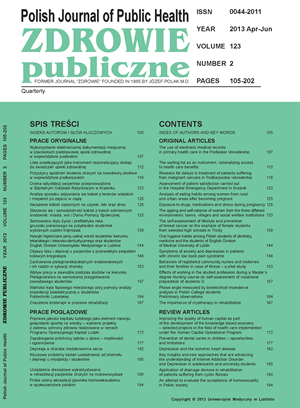Kluczowe problemy badań uzależnienia od internetu i depresji u młodzieży i studentów
DOI:
https://doi.org/10.12923/j.0044-2011/123-2/a.18Słowa kluczowe:
uzależnienie od internetu, studenci, młodzież, depresjaAbstrakt
Internet jest popularnym i użytecznym narzędziem, które stało się integralną częścią stylu życia w różnych kulturach, niestety może on też być przyczyną psychospołecznych problemów, jak szkodliwe używanie internetu (PIU) czy uzależnienie od internetu (IAD). IAD staje się przedmiotem międzynarodowych analiz – dotyczy osób które stopniowo tracą kontrolę nad czasem, który poświęcają internetowi mimo negatywnego wpływu na ich społeczne i psychologiczne funkcjonowanie. Nadużywanie internetu ma często negatywny wpływ na pracę zawodową, funkcjonowanie akademickie, relacje społeczne i finanse. Wśród objawów IAD wymienia się m.in.: przymus używania internetu, zaabsorbowanie nim, utratę kontroli, niepokój, napięcie psychiczne, wyobcowanie, depresję.
Następstwa IAD były szeroko badane od lat 90-tych, szczególnie społeczne, edukacyjne i somatyczne. Mniej uwagi poświęcono jego relacjom ze zmiennymi odnoszącymi się do życia psychicznego takimi jak: depresja, lęk czy stres. W znacznym stopniu badania te koncentrowały się na określeniu relacji między szkodliwym używaniem internetu a depresją.
W niniejszej publikacji dokonano przeglądu piśmiennictwa dotyczącego związków między IAD a depresją u adolescentów i studentów, szczególnie w odniesieniu do badań ujmujących depresję jako następstwo, współchorobowość lub istotny element, który może także pogłębiać objawy IAD. Przedstawiono także nowe podejście badawcze w odniesieniu do populacji młodzieży i studentów, znaczenie pełnej oceny diagnostycznej i leczenia depresji wiążącej się z IAD a także potrzeby badań regionalnych nad IAD szczególnie w środkowej i wschodniej Europie
Bibliografia
1. Clark DJ, Frith KH. The development and initial testing of the Internet Consequences Scales (ICONS). Comput Inform Nurs. 2005;23:285-91.
2. Kryspin-Exner I, Felnhofer A, Kothgassner OD. Pandora’s digital box: mental disorders in cyberspace. Neuropsychiatr. 2011;25:172-82.
3. Petersen KU, Weymann N, 3 nazwisko et al. Pathological Internet Use – epidemiology, diagnostics, co-occuring disorders and treatment. Fortschr Neurol Psychiatr. 2009;77:263-71.
4. Ha JH, Kim SY, Bae SC, et al. Depression and internet addiction in adolescents. Psychopathology. 2007;40:424-30.
5. Hinic D. Problems with Internet addiction diagnosis and classification. Psychiatr Danub. 2011;23:145-51.
6. Shaw M, Black D. Internet addiction: definition, assessment, epidemiol¬ogy, and clinical management. CNS Drugs. 2008;22:353-65.
7. Black DW, Belsare G, Schlosser S. Clinical features, psychiatric comor¬bidit, and health-related quality of life in persons reporting compulsive computer use behavior. J Clin Pshychiatry. 1999;60:839-44.
8. Christakis DA, Moreno MM, Jelenchick L, et al. Problematic Internet usage in US college students: a pilot study [online]. BMC Med. 2011;9. [1.03.2013].: www.google.pl/url?sa=t&rct=j&q=&esrc=s&source=web&cd=1&cad=rja&ved=0CDAQFjAA&url=http%3A%2F%2F www.biomedcentral.com%2F1741-7015%2F9%2F77&ei=E64wUejnCoayhAeOxIC4Dw&usg=AFQjCNEg55NpihOpLv9UQv93nw0qpled6A&bvm=bv.43148975,d.d2k
9. Grant J, Potenza M, Weinstein A, Gorelick D. Introduction to behavioral addictions. Am J Drug Alcohol Abuse. 2010;36:233-41.
10. Ahn D. Korean policy on treatment and rehabilitation for adolescents’ Internet addiction. In: International Symposium on the Counseling and Treatment of Youth Internet Addiction; 2007. p. 497.
11. Kraut R, Lundmark V, Patterson M, et al. Internet paradox: A social technology that reduces social involvement and psychological well being? Am Psychol. 1998;53:1017-31.
12. Ko C, Yen J, Chen C. Gender differences and related factors affecting online gaming addiction among Taiwanese adolescents. J Nerv Ment Dis. 2005;193:273-7.
13. Armstrong L, Phillips J, Sailing L. Potential determinants of heavier internet usage. Int J Hum Comput Stud. 2000;53:537-50.
14. Moreno MA, Jalenchick L, Cox E, et al. Problematic Internet use Among US youth: a systemic review. Arch Pediatr Adolesc Med. 2011;165:797-805.
15. Young K. Internet addiction: the emergence of a new clinical disorder. Cyberpsychol Behav. 1998;1:237-44.
16. Young K, Rogers R. The relationship between depression and internet addiction. Cyberpsychol Behav. 1998;1:25-8.
17. Fortson B, Scotti J, Chen Y, et al. Internet use, abuse, and dependence among students at a southeastern regional university. J Am Coll Health. 2007;56:137-44.
18. Abreu C, Karam R, Goes D, Spritzer D. Internet and videogame addic¬tion: a review. Rev Bras Psiquiatr. 2008;30:156-67.
19. Peukert P, Sieslack S, Barth G, Batra A. Internet – and computer game addiction: penomenology, comorbidity, etiology, diagnostics and thera¬peutic implications for the addictives and their relatives. Pyschiatric Prax. 2010;37:219-24.
20. Fischer G, Brunner R, Parzer P, et al. Depression, deliberate self-harm and suicidal behaviour in adolescents engaging in risky and pathological Internet use. Prax Kinderpsychol Kinderpsychiatr. 2012;61:16-31.
21. Hinic D. Symptoms and diagnostic classification of the internet addic¬tion disorder in Serbia. Prim Psihol. 2009;2:43-59.
22. Bernardi S, Pallanti S. Internet addiction: a descriptive clinical study focusing on comorbidities and dissociative symptoms. Compr Psychia¬try. 2009;50:510-6.
23. Aboujaoude E, Koran LM, Gamel N, et al. Potential markers for prob¬lematic internet use: a telephone survey of 2,513 adults. CNS Spectr. 2006;11:750-5.
24. Bowen MW, Firestone MH. Pathological use of electronic media: case studies and commentary. Psychiatr Q. 2011;82:229-38.


